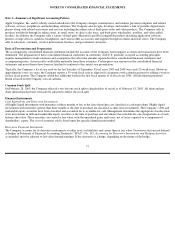Apple 2006 Annual Report Download - page 82
Download and view the complete annual report
Please find page 82 of the 2006 Apple annual report below. You can navigate through the pages in the report by either clicking on the pages listed below, or by using the keyword search tool below to find specific information within the annual report.
NOTES TO CONSOLIDATED FINANCIAL STATEMENTS (Continued)
Note 1—Summary of Significant Accounting Policies (Continued)
The Company records reductions to revenue for estimated commitments related to price protection and for customer incentive programs,
including reseller and end-user rebates, and other sales programs and volume-
based incentives. The estimated cost of these programs is accrued
as a reduction to revenue in the period the Company has sold the product and committed to a plan. The Company also records reductions to
revenue for expected future product returns based on the Company’s historical experience.
Generally, the Company does not offer specified or unspecified upgrade rights to its customers in connection with software sales or the sale of
extended warranty and support contracts. When the Company does offer specified upgrade rights, the Company defers revenue for the fair
value of the specified upgrade right until the future obligation is fulfilled or when the right to the specified upgrade expires. Additionally, a
limited number of the Company’s software products are available with maintenance agreements that grant customers rights to unspecified
future upgrades over the maintenance term on a when and if available basis. Revenue associated with such maintenance is recognized ratably
over the maintenance term.
Allowance for Doubtful Accounts
The Company records its allowance for doubtful accounts based upon its assessment of various factors. The Company considers historical
experience, the age of the accounts receivable balances, credit quality of the Company’s customers, current economic conditions, and other
factors that may affect customers’ ability to pay.
Shipping Costs
For all periods presented, amounts billed to customers related to shipping and handling are classified as revenue, and the Company’s shipping
and handling costs are included in cost of sales.
Warranty Expense
The Company provides for the estimated cost of hardware and software warranties at the time the related revenue is recognized. The Company
assesses the adequacy of its preexisting warranty liabilities and adjusts the amounts as necessary based on actual experience and changes in
future estimates.
Software Development Costs
Research and development costs are expensed as incurred. Development costs of computer software to be sold, leased, or otherwise marketed
are subject to capitalization beginning when a product’s technological feasibility has been established and ending when a product is available
for general release to customers pursuant to SFAS No. 86, Computer Software to be Sold, Leased, or Otherwise Marketed . In most instances,
the Company’s products are released soon after technological feasibility has been established. Therefore, costs incurred subsequent to
achievement of technological feasibility are usually not significant, and generally all software development costs have been immediately
expensed.
In 2004, the Company began incurring substantial development costs associated with Mac OS X version 10.4 Tiger (“Tiger”) subsequent to
achievement of technological feasibility as evidenced by public demonstration in August 2004 and the subsequent release of a developer beta
version of the product. The Company capitalized approximately $29.7 million and $4.5 million during 2005 and 2004, respectively, of costs
associated with the development of Tiger. In accordance with SFAS No. 86, amortization of this asset to cost of sales began in April 2005
when the Company began shipping Tiger and is being recognized on a straight-line basis over a three-year estimated useful life.
81
























